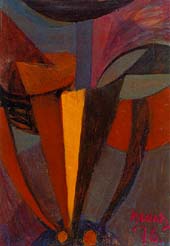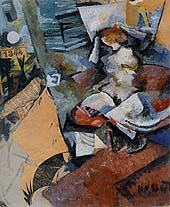

 Homage to Paolo Uccello 1976 |
Conti's renewed interest in Futurism, after the impact of his meeting with the
Futurists in 1913, took place in progressive stages, with his interest moving
towards poetry - his poetic prose in Imbottigliature of 1917 - the brilliant
colour effects to be found in his experiences in Fauvism - Self portrait in a
bathrobe at the seaside (1915) is emblematic of this period - and with music,
which Conti was moving away from, being reabsorbed into a style of painting that
evokes its temporality, voices and sounds.
This is perhaps what explains the connections between Conti's futurism and
Delauney's Orphism in France - closer to Balla and to Futurism than to Cubism -
which Apollinaire, not surprisingly, considered to have been influenced by
Matisse and the Fauves: "A completely new art that will effect painting, as it
has been conceived up until now, like music has for poetry. It will be painting
at its purest. Colour, one of the most sensitive elements in Conti's work, acts
as a vehicle to enlarge emotions, like music, with a potential articulation that
is independent of the subject, so as to eventually become the subject itself. In
other words, practically without ending". |
| The interest that Primo Conti was immediately to show in Futurist drawing as a form of writing, playing with his typographical translations in order to make his line capable of representing both space and colour, is what, in fact, freed him, from the very beginning, from the traditional volumetric compositions still used by Carrý, Boccioni and Soffici, allowing him to make a much richer start which, as can be seen from his late paintings, was to be of great benefit to him in his personal evolution. This idea of the line is what Conti's aphorism "All figurative art, with the exception of ex-voto art, is Liberty" refers to. The presence of Liberty cloison, Arte Nouveau, Fauvism and Futurism can in fact be found in all his painting and, more than actual velocity, tends to indicate tones that contain the rhythmic movements of a dancing line or, thanks to his brilliant intuition, barely brushes past its fusion with the cosmos. |
| Futurist spiritualism was thus resumed by Conti from its origins, as we can see in Simultaneous environment (1917) when compared with Matter by Boccioni. This painting shows the figure of the mother who receives the vivifying light from the universe above in her hands. Conti's painting instead portrays a room with a prostitute who is listening to the sounds from the road below and appears to be raised up as if by levitation, so that the interior and the exterior are in complete communication. The economy of line with which the artist simplified his forms in the Seventies allowed him to attain an even greater pictorial unity - poetry, rhythm - colour - with a simultaneous relationship that was stirred by the architypal image in his mind. In his Homage to Paolo Uccello (1976), the unexpected liberation of colour from the corset of the heraldic figure is crossed by a splash of yellow emerging from the soft colours used for the body and, like a repetitive musical score, endlessly translating a series of emotions like a kind of musical variation on a theme. |  Simultaneous environment 1917 |

| 
| 
|

